#ultrastenos
Text
Ultrastenos: Narrow Snouted Mekosuchine?
So this one comes with a pretty big disclaimer. Ultrastenos, evenmoreso than any other mekosuchine, is incomplete and enigmatic. Whereas animals like Mekosuchus at least bolster a long research history or at least somewhat complete remains of specific body parts, Ultrastenos is both new and fragmentary. This, combined with ongoing research, means that this reconstruction is just a preliminary one based on current publications and should not be taken as gospel.


Ultrastenos is best known through assorted skull fragments and crania, notably part of the quadrate and quadratojugal, the occiput (back of the skull), an incomplete lower jaw, misc. postcrania like a tibia and vertebrae and some referred skull tables.
Already we enter some weirdness as the type material all stems from the Low Lion Site of the Riversleigh WHA, while the skull tables are from the White Hunter Site (also Riversleigh). Tho they are roughly of the same age, both being late Oligocene, but they are still different localities.
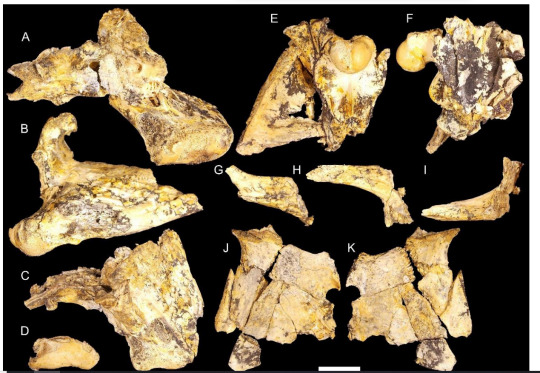
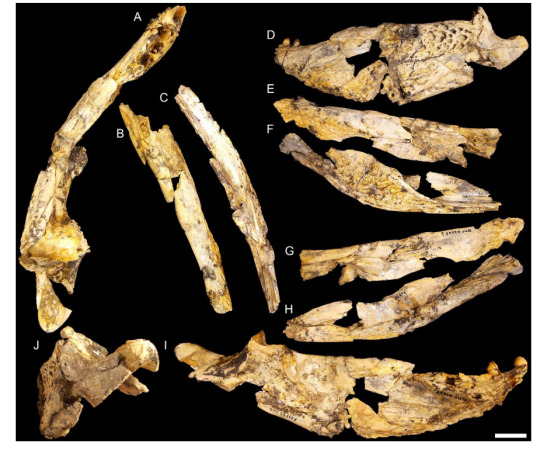
As is apparent both from my recon and the mandible, the lower jaw of Ultrastenos constricted weirdly rapidly, broad at the back and yet narrow towards the front (thus its name, which just means "extremly narrow").
A key issue here is that we don't know how long the rostrum was. We only have it up to the fourth-last tooth, so how long the snout would have continued we don't know. The idea that the snout was short has been entertained, but is deemed unlikely given that the mandible is very shallow. This would instead be more in line with long-snouted animals like gharials.
Size is another point of question. The type material is very small, only about two meters is what I recovered and the paper notes it's "only about as big as a freshwater crocodile", which matches fairly well I'd say. But it is not known whether or not the specimen was actually an adult, so we may find larger individuals in the future.

Which brings us to the disclaimer.
In 2023's "Migrations, diversifications and extinctions: the evolutionary history of crocodyliforms in Australasia", the confusion and uncertainty of Ultrastenos is once more brought up. Some of what is written is what you'd expect, which is that it's enigmatic and the interpretations of Stein et. al. need more research. Logical so far, its undeniably fragmentary and the interpretation is undeniably speculative. The fact that its phylogenetic placement among mekosuchines is a mess is likewise not a surprise. The original tree differs A LOT from more recent results, while the only other tree that included Ultrastenos is that of Rio and Mannion, which I generally avoid personally.
But the interesting nugget is that apparently, a close relative has been found since then which might have a big impact. But this research is still in prep courtesy of Adam Yates (who I've been told will publish the description of the Alcoota Baru soon enough). So will my recon become obsolete? Probably. But I'll update it accordingly once the time comes.

But lets briefly let go of safety and scepticism and consider the possibility that it really was a long-snouted mekosuchine. Aside from some of the anatomical clues like the shallow mandible, sameish teeth and narrow snout, a longirostrine croc would be expected, from the region, would it not? After all, long snouts evolved many times separately in crocs and despite having an incredibly diverse croc fauna, Australia is shockingly lacking in those. The only examples currently known are the Miocene Harpacochampsa, the Pliocene to Pleistocene Gunggamarandu and the current freshwater crocodile. The former two are gharials the later a crocodylid.
Furthermore, the White Hunter Site, if you remember prior posts, was positively teeming with mekosuchines of all different niches. Large semi-aquatic predators like Baru, small semi-aquatic ones like "Baru" huberi and terrestrial forms like Mekosuchus and Quinkana. So to fit in, Ultrastenos must have done something differently, and conveniently a longirostrine nische is still open. So why not.
Illustrations by Joschua Knüppe and Ashley Patch
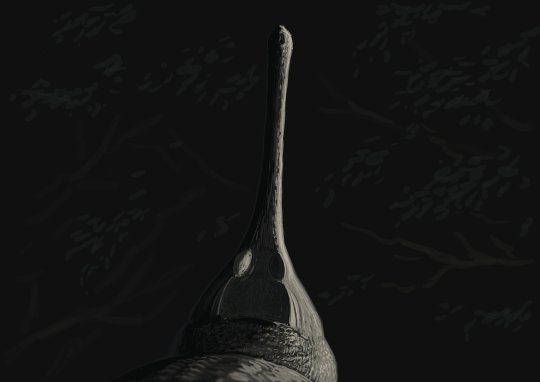
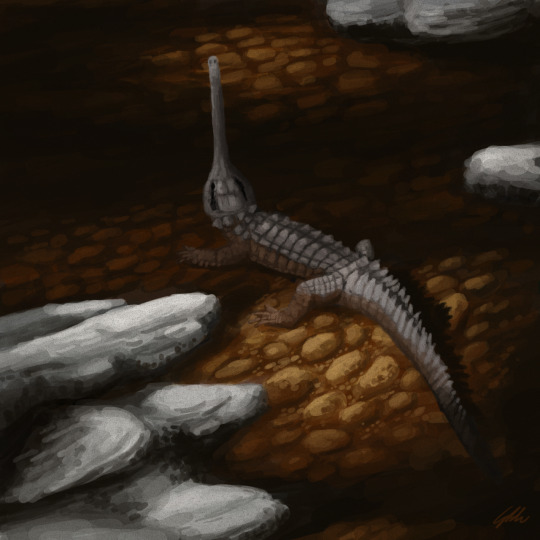
So that's it. Ultrastenos, the enigmatic, possibly longirostrine mekosuchine of the Riversleigh. Will this post age badly? Maybe, maybe not, we'll see.
Wikipedia: Ultrastenos - Wikipedia
Primary sources:
Stein, Michael; Hand, Suzanne J.; Archer, Michael (26 May 2016). "A new crocodile displaying extreme constriction of the mandible, from the late Oligocene of Riversleigh, Australia". Journal of Vertebrate Paleontology. 36 (5): e1179041. doi:10.1080/02724634.2016.1179041
Ristevski, J.; Willis, P.M.A.; Yates, A.M.; White, M.A.; Hart, L.J.; Stein, M.D.; Price, G.J.; Salisbury, S.W. (2023). "Migrations, diversifications and extinctions: the evolutionary history of crocodyliforms in Australasia". Alcheringa: An Australasian Journal of Palaeontology: 1–46. doi:10.1080/03115518.2023.2201319. S2CID 258878554
#palaeoblr#croc#prehistory#crocodile#paleontology#mekosuchinae#long post#ultrastenos#oligocene#riversleigh
22 notes
·
View notes
Text
The NEW Ultrastenos and its Ironic History
So those that have been keeping up with my posts on mekosuchines might recall the name Ultrastenos, as I've talked about this genus back in August of last year. If you've read that post you might also remember how I highlight at multiple points that a lot of the info was tentative on the basis that Ultrastenos was highly incomplete and that close relatives awaited description.
You may also remember "Baru" huberi, a small mekosuchine that lived roughly around the same time, clearly distinct from Baru yet at that point still unnamed. Oh, how I wished for the former to get more material and for the latter to recieve a proper genus assignment.
My now outdated reconstructions for "Baru" huberi (the small one in the left image) and Ultrastenos (right image)

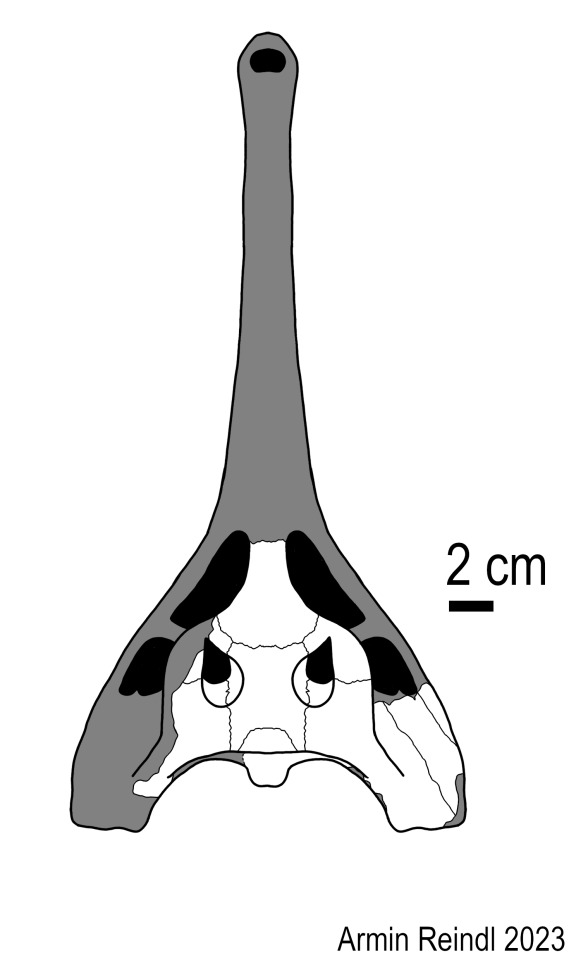
And then the monkey's paw curled.
As it turns out....they are the same damn animal.
Now, back when "Baru" huberi was described, Willis also named a bunch of other mekosuchines from the same locality (the White Hunter Site of the Riversleigh WHA) and described even more material that remained unnamed, including the White Hunter Cranial Form 1. Now, when Ultrastenos was named in 2016, the type material was from the Low Lion Site (also Riversleigh), but importantly, the skull tables identified as WHCF1 were also assigned to the genus (and were the basis for my reconstruction).
Well, re-examination has shown that the WHCF1 and the holotype of "Baru" huberi aren't just a single species.....THEY ARE A SINGLE INDIVIDUAL.
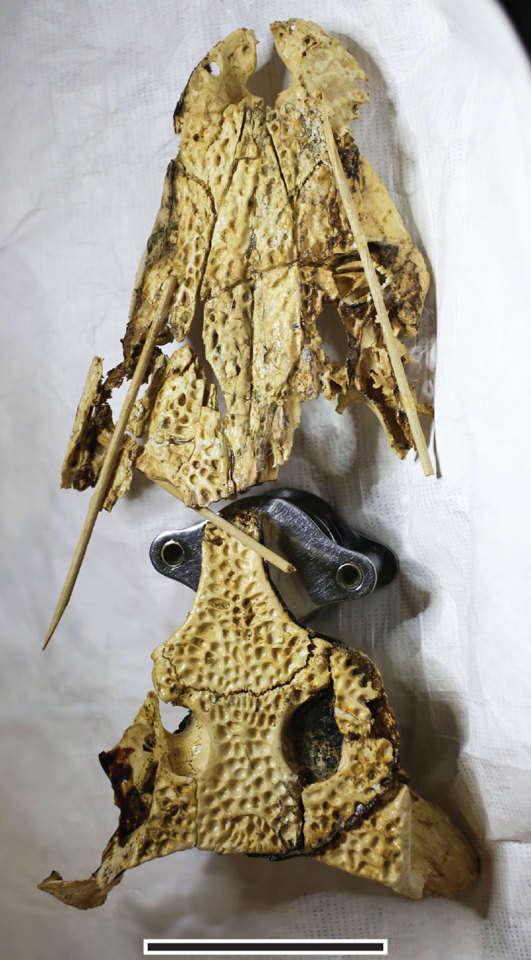
Given the fact that the assignment of the skull table to the Low Lion Ultrastenos material still holds up, this means that Ultrastenos willisi and "Baru" huberi are a single taxon. Which consequently requires some reshuffling of the names.
"Baru" huberi was named first, so the species name takes priority and continues being used. However, since it was never given a genus name, Ultrastenos does stay valid. Except now it's called Ultrastenos huberi, not Ultrastenos willisi.
A name that has aged like milk. Back in 2016 it was proposed that Ultrastenos had a very narrow snout (thus the name), so now that we know that the rostrum was flat and mesorostrine, the name really is just wrong.
So next up, lets examine what went wrong.
As I said before, Ultrastenos was fragmentary, so that certainly played a big part in it. But the team in charge of describing the animal still cited several lines of thinking to support their interpretation, most of which are now thoroughly debunked.
As an example, the lower jaw was rather shallow, however while this was initially taken as evidence for longirostry, the 2024 paper states that this only an argument against altirostry (a deep skull), not against a more generalized condition. The teeth were also initially used as evidence, citing their homodont condition (the teeth looked uniform), HOWEVER, the problem in that was that there were only a few teeth present, all of which notably do not bear any resemblance to the needle-like teeth seen in other long-snouted taxa. Another important clue initially taken to mean longirostry was the orientation of the quadrate area and the seemingly sudden constriction of the lower jaw. But the quadrate area was not found in articulation and would support a generalized skull form if simply rotated a little, while the constriction of the mandible appears to at least be partially exaggerated by preservation.
Of course, the fact that we now have proper material of the snout makes the interpretation of a generalized skull shape a lot more solid.
Image 1: The left and right halves of the mandible of Ultrastenos compared to that of Baru iylwenpeny (D), note how the right half is a lot more straight.
Image 2: The initial reconstruction of the quadrate area of Ultrastenos compared to one that is slightly rotated
Image 3: The revamped skull reconstruction by Yates and Stein

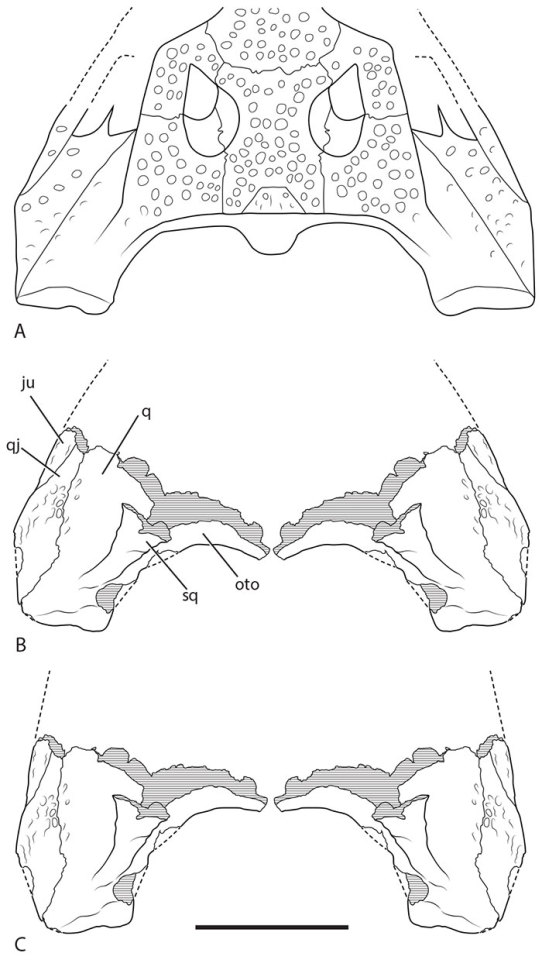
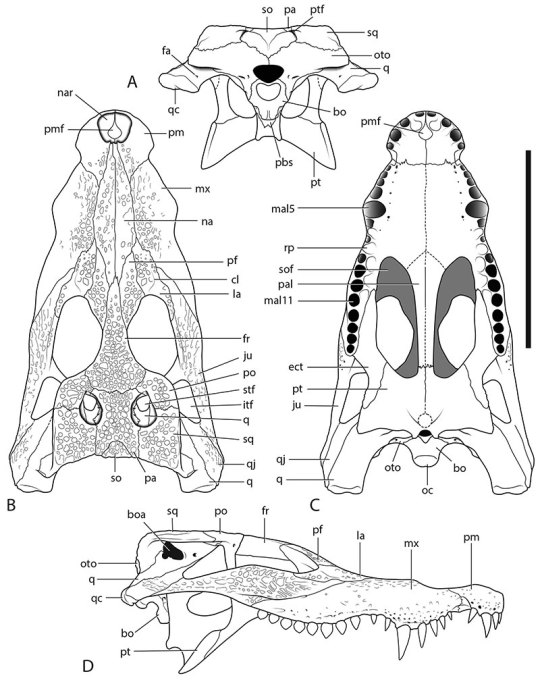
The size of the animal does stay relatively unaffected by these new discoveries. "Baru" huberi has been estimated at only around 1.5 meters in length and my own scaling of Ultrastenos got up to 2 meters, which seems to be in line with what is still assumed for this animal. So among aquatic mekosuchines, its still rather small.
There are however some interesting implications for mekosuchines at large. Now that we no longer have a longirostrine member of this family, one has to wonder, why is that?
Well, there might be several reasons.
It could be that the types of environments that were present in Cenozoic Australia simply didn't support such animals. Even in the type description, its been noted that the Riversleigh isn't exactly known for its fish remains, leading to the idea that Ultrastenos might have gone for other small vertebrates like frogs. Hell, the ecology of Baru might suggest that the reason that this genus was so robust might tie to the fact that the local bodies of water just weren't deep enough to allow the typical crocodilian grab-and-drown tactic.
Competition might have been another factor. In environments that may have been more suitable for such morphology, mekosuchines might have been beaten to the punch by other types of crocodilians. Harpacochampsa for example, tho originally thought to be a mekosuchine, is now more often regarded as either an unrelated crocodile or a gharial and its very possible that it filling the nische of a longirostrine simply meant that mekosuchines didn't have the opportunity to expand into that space. Same goes for Gunggamarandu in the Pliocene and Pleistocene and Freshwater Crocodiles from the Pleistocene onwards. (Tho it should be noted that both Harpacochampsa and Gunggamarandu are so fragmentary that their snout shape is technically unknown).
Images: Gunggamarandu (Eleanor Pease), Harpacochampsa (ArtbyJRC) and Freshies (Antoni Camozzato) might have been key factors in why mekosuchines never evolved slender snouts.
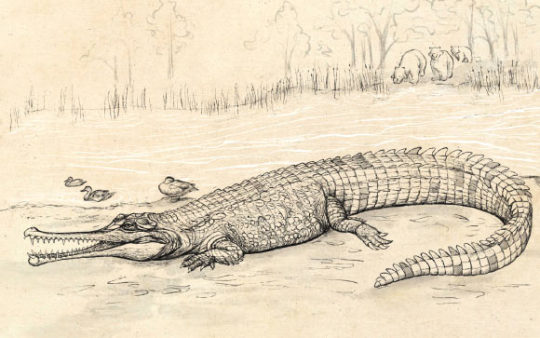
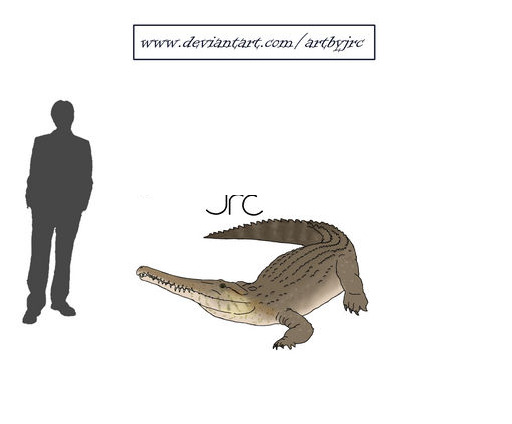
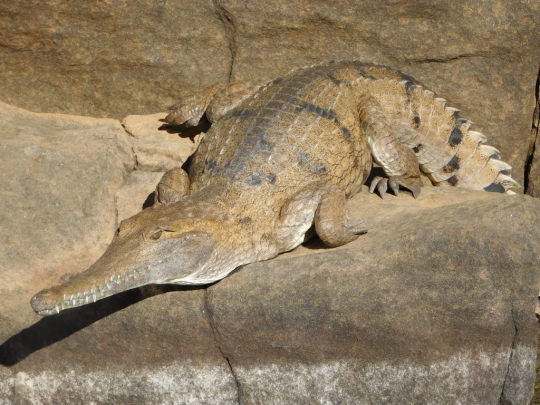
Finally, its also possible that something in the growth of mekosuchines simply prevents them from evolving longirostrine skulls, which Yates and Stein liken to alligatoroids (notably the closest alligatoroids got to traditional longirostry as seen in gharials is the Rio Apaporis Caiman, and even that one is closer to some extant crocodiles in its morphology).
Whatever the case, I for one mourn the loss of our long-snouted Ultrastenos. Tho as a note for any paleoartists, there is not a single illustration of this new interpretation since nobody ever drew "Baru" huberi either. Wink wink nudge nudge
Links:
https://en.wikipedia.org/wiki/Ultrasteno
Ultrastenos revised (palaeo-electronica.org)
#long post#harpacochampsa#ultrastenos#baru huberi#mekosuchinae#gunggamarandu#oligocene#riversleigh#paleontology#palaeoblr#croc#crocodile#crocodilia#prehistory#cenozoic
3 notes
·
View notes
Text
Mekosuchus
My recent-most Wikipedia deep dive was in equal parts enlightening and frustrating and it concerned no other than Mekosuchus, everyones favourite heartbreaker of a recently extinct crocodile.
For those unfamiliar, let me give you some footnotes before getting into the nitty gritty. Mekosuchus is, or was, a genus of terrestrial (NOT ARBOREAL) dwarf crocodile from Australasia, first appearing during the Late Oligocene. They were small, how small we don't precisely know but its generally estimated that adults would be in the 1-2 meter range (so about 3 to 6 feet I believe?). The heartbreaking part? The last confirmed Mekosuchus died out only 3.000 years ago, and some publications even suggest they could have stuck around until just 1.700 years ago. Yeah, we got REALLY close.
Art by yours truly, I'll explain the massive difference down below, just be patient.

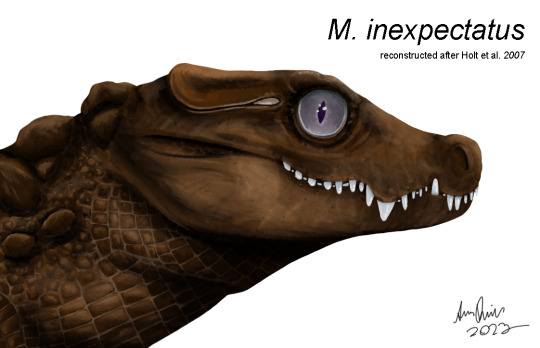
But lets get some of the basics out of the way. Mekosuchus was a small mekosuchine crocodilian and currently, four species are recognized. Mekosuchus whitehunterensis is the oldest from the Oligocene/Miocene of mainland Australia, immediately succeeded by M. sanderi during the Miocene. Both these species were described as having had blade-like posterior teeth (at the back of the jaw) and both coexisted with a ton of other crocs, including Baru, Quinkana and some bizarre ones like Ultrastenos.
After a bizarre break in the fossil record, Mekosuchus shows up again during the Holocene on the islands of New Caledonia and Vanuatu, ironically mirroring the meiolaniid turtles I talked about previously. Fossils are securely dated to about 3.000 years ago, but Balouet and Buffetaut also suggested that some of the younger remains may only be 1.720 years old, overlapping with human settlements. But this isn't accepted by everyone. Regardless, these species differ from their older cousins by lacking the blade-like teeth, instead going for crushing dentition.
Art by artbyjrc and Kahless28
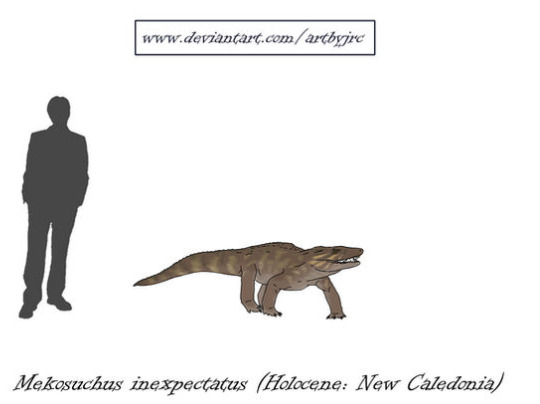

With such different teeth comes different ecology, of course. A 2015 study suggests that the neck vertebrae of M. whitehunterensis were well adapted to rapid stresses, specifically caused by side-to-side movement of the head. It is thus speculated that they shook their heads to strip meat from carcasses, rather than performing the iconic death roll (as that might hurt the animal on land).
M. inexpectatus meanwhile was seemingly better adapted at crushing hard-shelld things, crabs, insects, maybe snails even. Holt and colleagues suggest that it might have lived much like a modern dwarf crocodile, spending its time in river streams and coming out at night to forage.
Dwarf crocodile via the San Diego Zoo and Mekosuchus illustrated by my friend BatmanelVisigodo


Both however are thought to be terrestrial, having short, altirostral skulls, big eyes and nares that face sideways, not upwards as in semi-aquatic crocodilians. They were however NOT ARBOREAL. Yes I know I know, its a bummer. To those unaware, a commonly cited missconception is that Mekosuchus was a tree-dweller, which was originally suggested by Paul Willis in the 1990s. However, this was more of an off-hand comment at the time that certain people (including me in the past) have run with, causing it to spread and be almost considered fact by some. Hell, it says a lot when Mekosuchus, in many circles, is thought of as "that tree croc".
However, not only was Willis suggestion based on the now outdated notion that monitor lizards weren't around at the same time, later authors also note that the toes of Mekosuchus really don't show any adaptations to climbing specifically. So alas, it would seem that this was only a myth. But don't worry too much, sometimes crocs climb regardless, just not vertically up a tree.
Mekosuchus artwork by Manusuchus
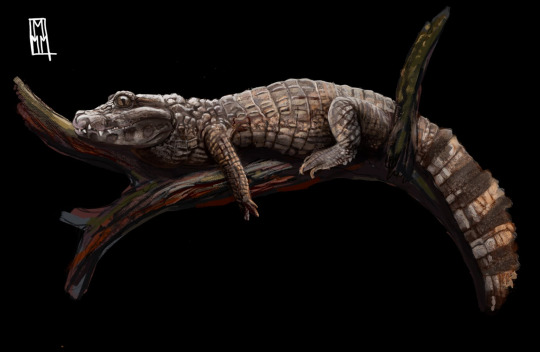

Now at the beginning I teased that there's a reason why my images for M. whitehunterensis and M. inexpectatus look so different. Well its kind of painful really. Despite being known for about 30 years now, with 300+ bones known from New Caledonia alone, Mekosuchus is incredibly poorly studied. The original description only figured around half a dozen bones and while the next three species were all named in the span of just 5 years, they are all incredibly fragmentary. And then, just after another expedition collected more bones....things went silent.
The last 20 years saw the publication of only a single paper extensively dealing with Mekosuchus itself, with two skull reconstructions coming out in less detailed sources.
The first is Holt et al. 2007, a powerpoint presentation from a paleontological conference. The presentation made some fascinating claims and even provided a reconstruction of the skull, but sadly. Nothing ever came of it, the research was never formally published and the lead author has since then changed fields into Astronomy. Actually had a nice talk with him earlier today.
Then there's Scanlon 2014, which offers even less. In the book Carnivores of Australia: past, present and future, Scanlon briefly touches upon mekosuchines, featuring a new composite reconstruction of M. whitehunterensis. However, this is not elaborated on in the text, despite the drastic differences to how M. inexpectatus has been reconstructed before. So we are left with two very different appearances. Are they simply really different looking species? Is one interpretation faulty? Should Mekosuchus be split? Who knows, might be a while until we figure it out. But until then, here's the two together, one looking much like a dwarf crocodilian, the other more like a sebecid. An interesting contrast for sure.

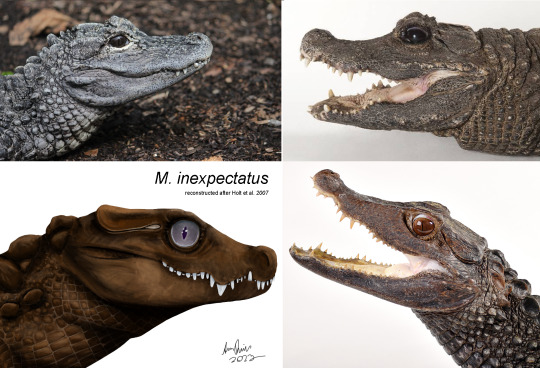
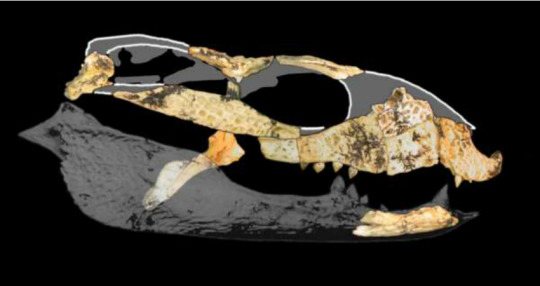
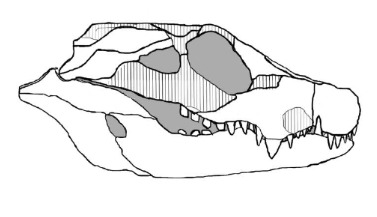
As per usual, this research was done as part of me doing a major haul of a Wikipedia page which you can read here Mekosuchus - Wikipedia. It's been an interesting, if a little frustrating task, but it was fun properly reading up on this animal and putting this information out there for people that don't wanna dig through 30 years of literature (including one paper in French).
Hopefully I suceeded, at least the page is a bit bulkier now.
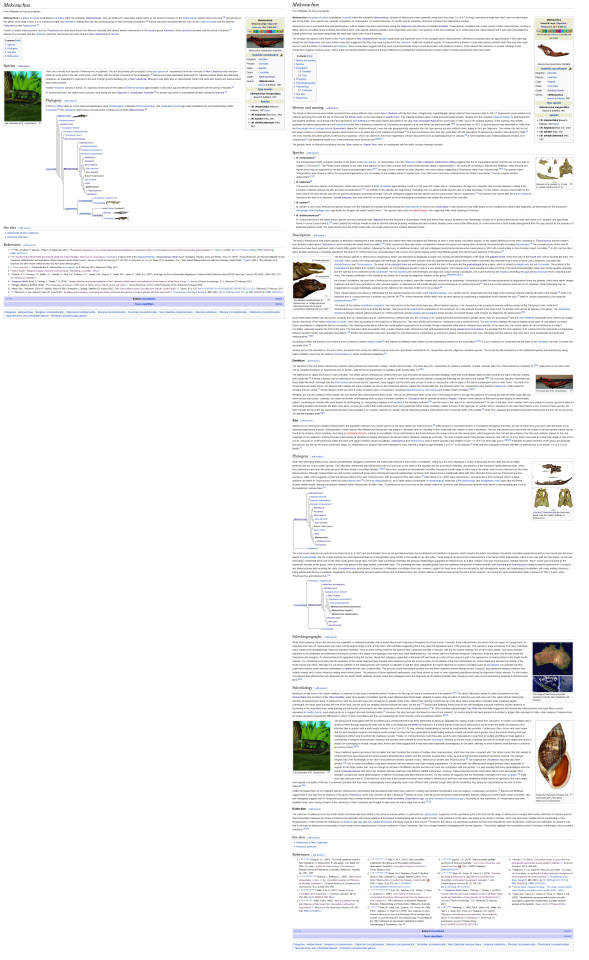
#wikipedia editing#palaeoblr#paleontology#prehistory#long post#crocodile#mekosuchus#land crocodile#mekosuchinae#new caledonia#extinction#paleo#science
182 notes
·
View notes
Text
Kalthifrons and the Fall of Mekosuchines
The penultimate singular mekosuchine I'll talk about here is Kalthifrons, one of the more obscure members of this clade. After all, Kalthifrons was named only in 2017 and unlike some other animals like Ultrastenos, it does not stand out as much morphologically. But I still wanna take a moment to talk about this medium-sized Pliocene croc, its potential fate and the implications for its relatives.
Left: The skull of Kalthifrons (Ristevski et al. 2023)
Right: A reconstruction of how the skull may have looked like intact


In many respects Kalthifrons looks very typical for a crocodilian, with a triangular head, rounded snout and eyes that face upwards. There are some interesting factors to mention, at least imo, and one thing thats sorta unknown. Starting with the unknown, what we aren't sure about is how deep the skull is. Sure the skull of Kalthifrons looks very intact in top view, but when looking at it from the side its about as flat as a sheet of paper. So we can't exactly tell how deep the skull would be. Maybe it was not much different from a modern croc...or maybe it was comparable to Baru the cleaver-headed crocodile. We simply don't know. The other two interesting things about its anatomy are more subtle. For one, the tip of the snout is comparably narrow. Now generally, if you look at mekosuchines the premaxilla and external nares tend to be wider than long, even in Australosuchus, but in Kalthifrons they are longer than wide. And then there's the frontal. The name Kalthifrons derives from the Latin word for forehead and the Dieri word for spear. The reason why is that the frontal bone, which covers the forehead, has an exceptionally long spear-like process at the front. Sure such a process is also found in other crocs, but in Kalthifrons it makes up 64% of this bones entire length.
A hypothetical reconstruction showing the size of Kalthifrons, which may have been around 3.4 meters.

With a length of possibly up to 3.4 meters and a triangular skull, Kalthifrons was probably a fairly generalist hunter. Fossils of Kalthifrons are known from a single place, the Golden Fleece Locality along the shores of Lake Palankarinna in the Lake Eyre basin, South Australia. Now this locality primarily yields two things. Croc fossils and turtles. Based on this and certain minerals in the sands of this locality, it has been suggested that the Golden Fleece Locality once housed a waterhole that dried up, leading to the deaths of its inhabitants.
The death of Kalthifrons as illustrated by Joschua Knüppe.
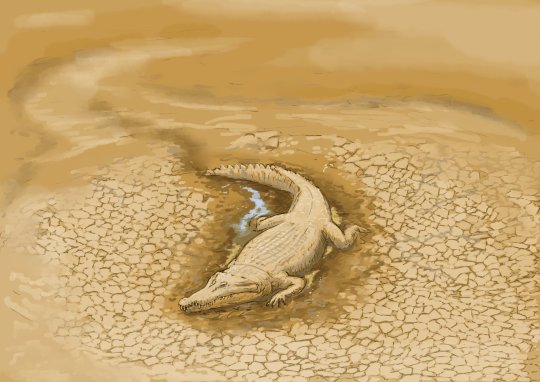
Which leads us to a bit of discussion regarding the general state of mekosuchines during the time of Kalthifrons. Now if you have read my previous posts on mekosuchines, you'll notice one thing. Most species native to continental Australia were around during the Oligocene to Miocene. Australosuchus, Baru, Ultrastenos, "Baru" huberi, Trilophosuchus and the continental Mekosuchus species. After the Miocene, continental species become rarer. Really you got Paludirex, Kalthifrons and Quinkana. And even they wouldn't stick around for much longer, with the last mekosuchines of Australia going extinct at the end of the Pleistocene.
So obviously mekosuchines experienced a drastic fall in diversity towards the end of the Miocene, clinging on for a few more million years before disappearing forever. But there's another thing that happened around this time. Modern crocodiles showed up. Contrary to popular belief, today's crocodiles of Australia are relatively recent arrivals. Freshwater crocodiles only lived there since the Pleistocene and saltwater crocodiles were likely even more recent, with both of them having evolved from different ancestors and arrived in Australia independently. But there's at least one more species of Crocodylus. The as of yet unnamed Tirari Desert Crocodile is known from remains that date to strata slightly more recent than that of Kalthifrons, displaying similar generalized anatomy. Like freshies and salties, the Tirari Crocodile arrived on its own, with phylogenetics indicating that its closest relatives were the palaeoafrican crocodiles like Crocodylus thorbjarnarsoni (a giant that grew up to 8 meters long).
Crocodylus species of Australia
Top left: The freshwater crocodile (Ristevski et al. 2023)
Bottom left: The saltwater crocodile (Ristevski et al. 2023)
Right: Stratigraphy of the Lake Eyre Basin and successions of local crocodilians (Yates and Pledge 2017)

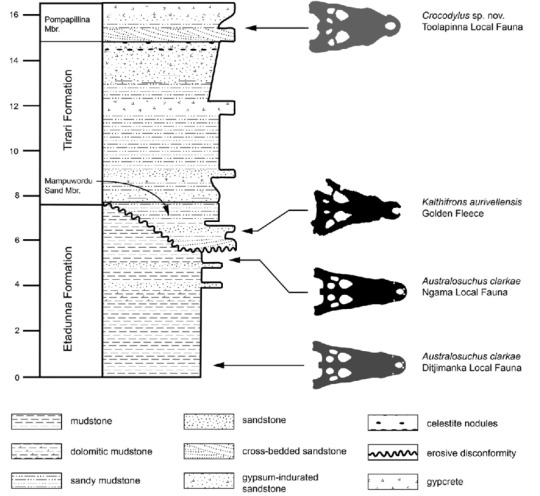
Did Crocodylus drive Kalthifrons to extinction? Well, maybe? Yates and Pledge discuss this possibility in the description of Kalthifrons, suggesting that theres some supporting pieces of information for this hypothesis. Not only does the arrival of the Tirari crocodile match up nicely with the disappearance of Kalthifrons, but they both share very similar anatomy. And conventional wisdom suggests that two crocs of the same morphotype don't really coexist in the same habitats.
But there's also points against that which aren't as openly discussed. Namely, the lack of material. Sure we have Kalthifrons in the older Mampuwordu Sand Member and the Tirari Crocodile in the younger Pompapillina Member, but remember. We only have that one Kalthifrons individual. We further know little about their habitat preferences. Sure conventional wisdom suggests crocs with similar morphology don't coexist, but that doesn't mean they don't overlap. Some species may very well be separated by the specific habitat they prefer. Slow open water, fast moving streams. Finally, is replacement necessarily the only answer? Not really. It has been deduced that Kalthifrons died in a drought and aridification is regarded as one of the main drivers of Australian megafauna extinction, as touched on in my summary of Paludirex. Maybe that's it? Kalthifrons was driven to extinction when environmental conditions grew too harsh, with Crocodylus entering the newly opened niche. This may parallel what happened in Miocene Africa, when rainforests disappeared osteolaemine crocodiles likely gave way to Crocodylus, which was better suited to the dryer climate.
Whatever the case, Kalthifrons is one of the most recent mainland mekosuchines and thus may be critical for us to determine what happened during this part of Australia's history. So sure it might not be flashy, but it's still an important little guy.
#mekosuchinae#kalthifrons#palaeoblr#prehistory#paleontology#pliocene#australia#croc#crocodilia#extinct#extinction#long post
90 notes
·
View notes